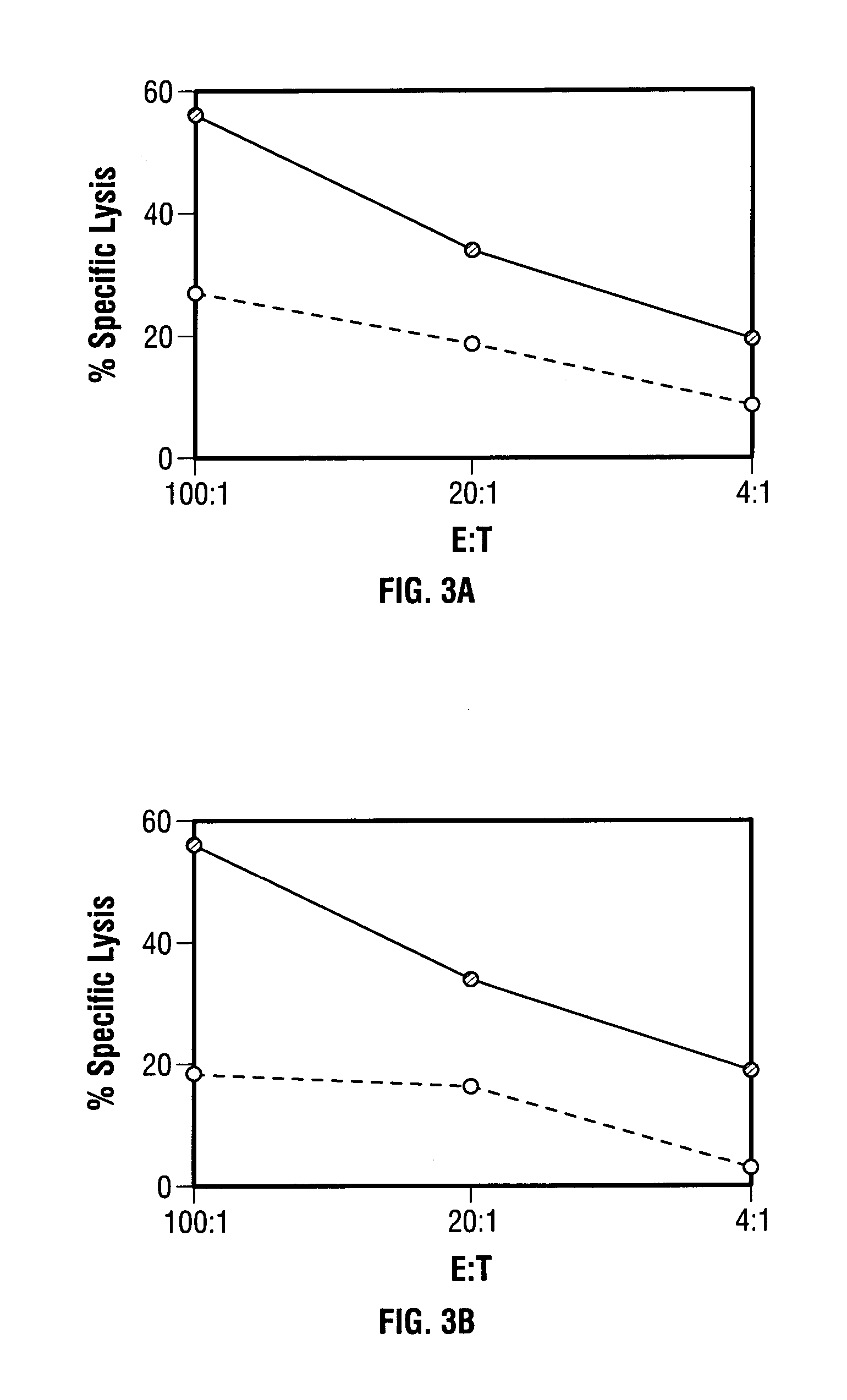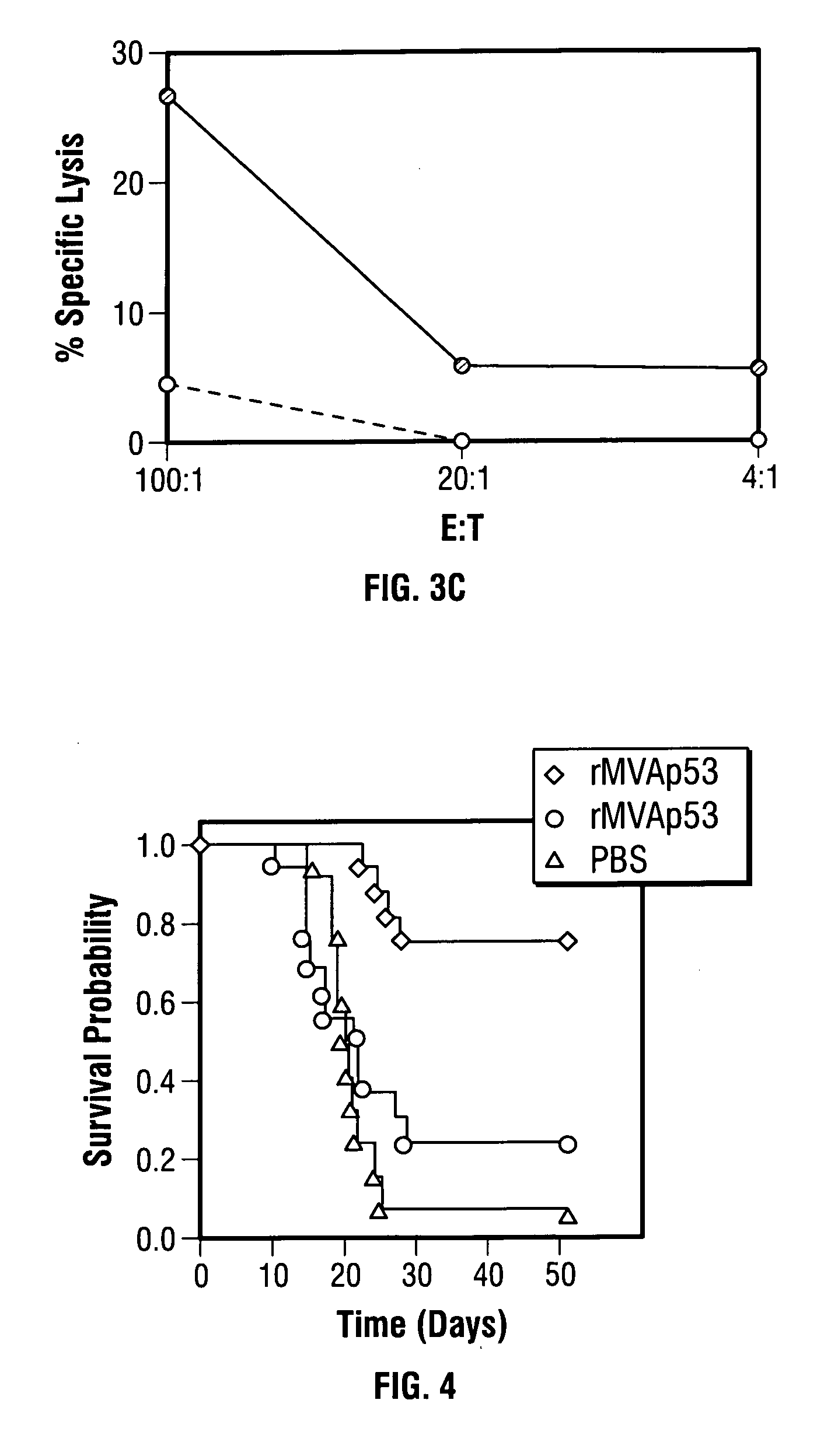Modified vaccinia ankara expressing p53 in cancer immunotherapy
a technology of vaccinia ankara and cancer immunotherapy, which is applied in the field of tumor immunology, can solve the problems of limiting the effectiveness of p53-directed immunotherapy, time-consuming and expensive ctl infusion and infusion of epitope pulsed dendritic cells, and each strategy has considerable drawbacks in clinical applicability
- Summary
- Abstract
- Description
- Claims
- Application Information
AI Technical Summary
Problems solved by technology
Method used
Image
Examples
example 1
Expression of Murine p53 Protein By rMVAmup53
[0078] Expression of murine p53 protein following infection with rMVAmup53 was analyzed to determine the fidelity and extent of its expression from recombinant virus. Lysates were prepared from BHK or HEK 293 cells infected with rMVAmup53 and subjected to SDS-PAGE and Western blotting. Standard Western Blotting techniques were performed using an ECL Western Blot Kit (Amersham Pharmacia Biotech, England). The samples were incubated with a purified mouse anti-p53 monoclonal antibody, PAb 122 (Gurney 1980), followed by incubation with a peroxidase labeled goat anti-mouse secondary antibody provided in the ECL Western Blot kit. Western blot analysis of BHK cells infected with rMVAmup53 demonstrates abundant p53 expression (FIG. 2). The remarkable level of expression exhibited by rMVAmup53 compared to other viral and cellular forms demonstrates its usefulness in vaccination-protocols. As shown in FIG. 1, the volume on the rMVAmup53 lane is bet...
example 2
In vitro Generation of a p53-Specific CTL Response By rMVAmup53
[0079] Vaccination of mice with rMVA expressing viral and tumor associated antigens results in enhanced antigen specific CTL responses. One goal of this example was to determine if vaccination with rMVAmup53 could break p53 tolerance, resulting in the generation of p53-specific CTL. Mice were vaccinated i.p. with 5.times.10.sup.7 pfu of either rMVAmup53 or rMVApp65. After two weeks, spleens were harvested and disassociated, and splenocytes were washed and counted.
[0080] Splenocytes were restimulated in vitro for 6 days with syngeneic LPS blasts infected with rAd-mup53 or rMVAmup53. Na-.sup.51CrO.sub.4-labe-led target cells that overexpress wt p53 were added to 96 well plates with the effectors, in triplicate, at various effector to target ratios, in 200 .mu.l of complete medium. The plates were incubated for 4 hours at 37.degree. C., and the supernatant was harvested and analyzed. Percent specific lysis was calculated us...
example 3
In Vivo rMVAmup53 Tumor Challenge Experiments
[0081] Since a single vaccination with rMVAmup53 resulted in enhanced CTL responses, there was sufficient justification to examine the effect of rMVAmup53 vaccination on the growth of tumor cells in vivo.
Statistical Methods
[0082] For experiments where the growth rate of some tumors necessitated early sacrifice, growth curves were compared by the time to a fixed size using a logrank test. Contrasts of single groups to all others were conducted after a single omnibus test. For cell depletion experiments, all mice were followed for a fixed amount of time, and final tumor size was compared by the Wilcoxon rank-sum test, after a significant Kruskal-Wallis test if there were more than two groups. For survival experiments, a logrank test was used.
rMVAmuD53 vs. Meth A Cells
[0083] Six-week-old female Balb / c mice were injected by subcutaneous (s.c.) route in the left flank with 5.times.10.sup.5 Meth A cells. Mice injected s.c. with Meth A cells dev...
PUM
| Property | Measurement | Unit |
|---|---|---|
| pH | aaaaa | aaaaa |
| volume | aaaaa | aaaaa |
| volume | aaaaa | aaaaa |
Abstract
Description
Claims
Application Information
 Login to View More
Login to View More - R&D
- Intellectual Property
- Life Sciences
- Materials
- Tech Scout
- Unparalleled Data Quality
- Higher Quality Content
- 60% Fewer Hallucinations
Browse by: Latest US Patents, China's latest patents, Technical Efficacy Thesaurus, Application Domain, Technology Topic, Popular Technical Reports.
© 2025 PatSnap. All rights reserved.Legal|Privacy policy|Modern Slavery Act Transparency Statement|Sitemap|About US| Contact US: help@patsnap.com



